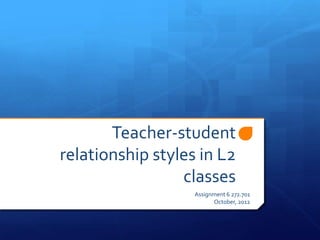
Diana g. presentation
- 1. Teacher-student relationship styles in L2 classes Assignment 6 272.701 October, 2012
- 2. A personal case-study on… • how the teacher-student relationship style is manifested in teaching English as a second language to Chinese students, and teaching French to NZ students; and • how this changes, giving way to a more effective teacher-student relationship style when the culture factor is considered
- 3. Sources: Oxford, R., Massey, R. & Anand, S. (2005). Transforming teacher-student student relationships: Toward a more welcoming and diverse classroom discourse. In J. Frodensen & C. Holten (Eds), The power of context in language teaching and learning (pp. 249-266). Heinle: Boston Sally Chan, (1999), “The Chinese learner – a question of style”, Education + Training, Vol. 41 Iss: 6 pp. 294 – 305 REVIEW AND EVALUATION OF INTERNATIONAL LITERATURE ON MANAGING CULTURAL DIVERSITY IN THE CLASSROOM Prepared for the Ministry of Education and Education New Zealand http://www.minedu.govt.nz/~/media/MinEdu/Files/EducationSectors/InternationalEdu cation/ProvidersOfIntEd/InternationalismClassRoomStrategies.pdf Clive McGee, Richard Ward, Joan Gibbons, Ann Harlow TRANSITION TO SECONDARY SCHOOL: A LITERATURE REVIEW Report to the Ministry of Education University of Waikato
- 4. Types of teacher-student relationships styles As indicated by Oxford et al (2005), as a result of a number of studies and particularly the two regarded most comprehensive (Oxford, 2001b; Oxford et al., 1998) on the critical analysis of power and intimacy in teacher-student style relationships there have been identified three teaching modes: autocratic or authoritarian (teacher holding the power, distant from students, dictatorial), laisser-faire (classroom chaos, teacher characterised by lack of power, disorganised, unengaged) and democratic-participatory (teacher involved, power is shared by both the teacher and the students) teaching.
- 5. The Clash of Styles “…teacher-student style conflicts arose when the instructor’s teaching style and the student’s learning style were severely mismatched…” Oxford et al (2005) When the instructor’s teaching style and the student’s learning style do not coincide a serious clash, especially across cultures can occur according to Oxford et al (2005).
- 6. Case-study 1: Teaching ESL to Chinese students As a result of a teacher-student democratic-participatory relationship style was exercised in teaching a small group of Chinese students, aged 14- 15, studying English as a second language at the intermediate level, the following has been noted: Students felt uncomfortable to express their opinions on the given situation Silence was mostly predominant in the classroom Students needed a lot of encouragement, guidance The discussion was mostly led by the teacher, with very little student participation Students found it hard to engage in the open-discourse approach
- 7. Why? Short answers: The teacher-student relationship style mismatched Cultural factor was not fully considered
- 8. Findings The results appeared to be not so favourable for either the teacher, who tried to impose the teaching methods based on student- centred approach, nor the students, who showed resistance to these techniques, until the authoritarian style was increased. Consider the following: “Typically, Chinese classroom activities are dominated by lectures with limited questioning or discussions since students prefer not to express their opinions in public. …so as not to embarrass or offend others. ... … In the classroom this may be manifested as students ‘losing face’ for poor performance… The concept of ‘chi’ih’ or shame comes hand-in-hand with ‘lien’ [confidence] and its existence is fundamental to the concept of face for the Chinese.” “The typical [Chinese] classroom would therefore appear to be highly authoritarian to maintain control…(Biggs, 1994)” Sally Chan (1999)
- 9. Case-study 2: Teaching French to NZ students And when applying the authoritative teacher-student style to NZ students learning French the following results occur: Students were non-responsive and were not fully engaged Students were losing interest Students found it hard to relate to the tasks and found them insipid. The authoritarian style, though, was beneficial in eliminating disciplinary issues.
- 10. Why? The same answers: The teacher-student relationship style mismatched Cultural factor was not fully considered
- 11. Findings Again, the results were not pleasing. Although it eliminated the disciplinary issue and the students were more submissive, it failed to achieve the desired result, because the teacher was trying to “homogenize all voices into a single “right way” of speaking and writing.” (Oxford et al, 2005) Consider these: “As per some studies the individualistic approach is common in NZ schools, where students’ individualities are highly considered and their individual learning styles are counted for.” “A relationship of working together and interacting as learners and teachers” REVIEW AND EVALUATION OF INTERNATIONAL LITERATURE ON MANAGING CULTURAL DIVERSITY IN THE CLASSROOM Prepared for the Ministry of Education and Education New Zealand “Preferred learning styles such as small group work, active learning and oral learning may be better accommodated” TRANSITION TO SECONDARY SCHOOL: A LITERATURE REVIEW Report to the Ministry of Education University of Waikato Clive McGee, Richard Ward, Joan Gibbons, Ann Harlow
- 12. To find harmony Case-study 1: The approach described in Oxford et al (2005), as a result of one of the studies seems to have relevance to this case: “…it is important to respect students’ centralising desires in order to gradually guide students toward more flexible, communicative tasks.” (Oxford et al, 2005) Case-study 2: The cultural factor had to be considered, as according to the findings on slide 11 it would have facilitated the teacher-student relationship and added some balance to the asymmetrical discourse, which in turn would evolve into a more democratic- participatory style that seemed to be more favoured by NZ students.
- 13. In conclusion Oxford et al (2005) suggest some recommendations for “transforming Style Conflicts and Promoting Style Harmony”: 1. “Pay attention to the directions of power, interaction, and discourse in the classroom 2. Know ourselves well 3. Look at styles much more dynamically 4. Stretch that style – and simultaneously promote style harmony 5. Consider cultural and personal differences and the possibility of developing new voices.” Oxford et al (2005)
